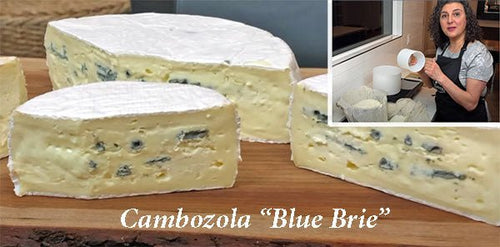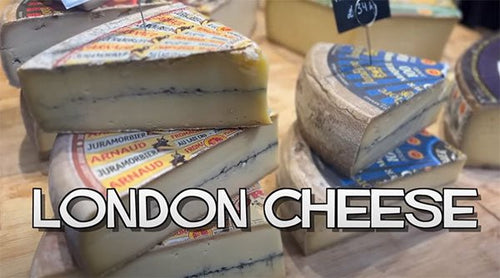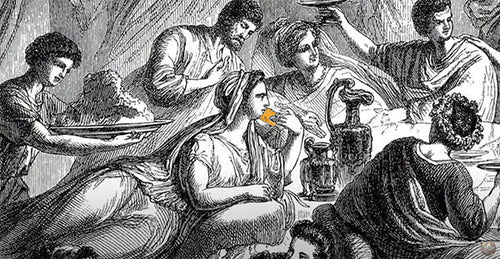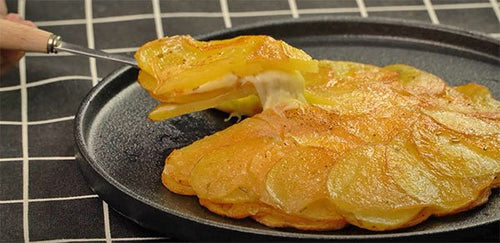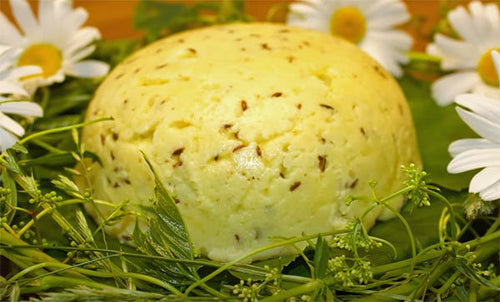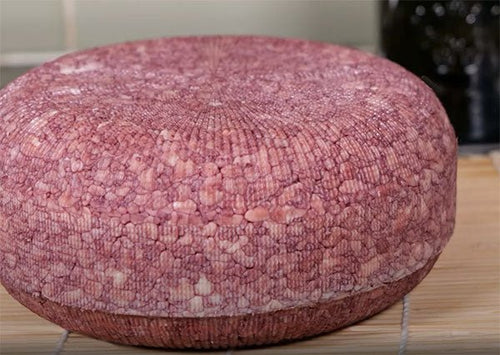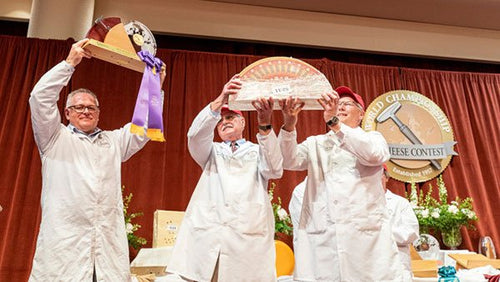Cheese Making Recipe of the Month
Munster Style Cheese
Munster is a semisoft cows milk cheese with an orange colored rind. Its flavor ranges from mild when young, to quite strong for well aged cheeses.
This is one of my favorite cheeses when done well. Ripening consists of natural yeast that settle in after molding, Geotrichum, and B.linens
Developing Natural Rinds
In this session we look at what is involved after the cheese leaves the press in order to get it to the aging area in the best condition to ensure a successful ripening.
How do we get the cheese from the fresh stage we see shown at the left ..
to the condition you see pictured on the right ready for the aging process.
Cheese Making Questions & Answers
3 Culture Questions
Q ... I make a one quart batch of Chevre 3-4 times a week and am having problems with my cultureand am wondering if you can help me see possible solutions. I use grocery store buttermilk and it is fine for the first few days and then it ceases to adequately culture the milk and the cheese comes out poorly.
A friend told me about your Chevre powder that has the culture and rennet together. Can I divide up the packet to make multiple small batches? I see it cultures up to a gallon of milk, but I never have that much at one time.
My other question is about the mesophilic culture. How is it made and does it stay viable for longer than store bought buttermilk?
A.. First off you should understand about cultures
.. when they are asked to work too hard or are not given continuous nutrient and just sitting in an aging batch , they do a very poor job.. hence the buttermilk might work the first time but will get weaker w/ each batch
... our culture is a very specific one that has been especially designed to be kept frozen until use ... when given a few minutes ripening time they are ready to go to work in optimum condition.
You will find that your reliability factor is almost perfect w/ these
... we have designed these packs for 1 gallons of milk but you might try your hand at dividing a pack between 2 batches keeping things as sanitary as possible.
The mesophilic culture is made in much the same way I have described above
... these are very specific cultured bacteria in their prime .. dried and frozen to hold them there and mixed in with a nutritional substrate that helps them become active in fresh milk
... after a brief ripening time (the lag phase) .. they begin producing the acid (growth phase) from the milks lactose and your cheese is under way
Q... I still cannot figure out why my curds were still very loose after the “resting” period Following the addition of rennet ( I let it rest about 15 minutes for my second batch, my first batch rested about 7-8). I cannot help but continue to ask myself if it was something I did wrong or maybe the milk needed to rest longer. Any suggestions you can give me would be greatly appreciated.
A..This is most probably due to the nature of the milk you are getting ... curd strength is related to the amount of protein/calcium in the milk ... fresh farm milk has the best balance and hence the strongest curds .. store bought milk will vary in protein/calcium due to processing temps and aging .. the more heat they apply and the longer it is cold stored the weaker this Protein/Calcium balance becomes, hence the weaker the curd
.. In all of our photos and workshops we use store bought milk but choose LOCAL production and look for it FRESH .. the results are what you see on the website
...The following arrived in our mail a few days later:
Jim .. Patience does pay! My second batch resulted in THE MOST AWESOME MOZZARELLA I have ever seen!!!
Q... I was looking at other recipes recently. Each one talks about greatly varying amounts of mesophilic starters. One asks for 4 oz. of meso starter culture, another for one cup. I buy mine in packs from your site. What are the equivalents?
A..The 4 0z and 1 cup are for a mother culture which has already been made up ... usually the amount should be between 1-2% of the milk vol so for 2 Gal (256oz) the amount should be 2.5-5 oz. of starter ... but this will depend on your milk .... our starter culture packs are designed to work for 2 gal but will work for up to 3-4 gal of milk .. this would be equivalent to the 1-2% of mother/bulk culture
Have a cheese making question, we're here for you: info@cheesemaking.com
Meet Some Fellow Cheese Maker
Maria Trumpler Needed Raw Milk Vermont Family Needed A Side Business
Bouncing from one teaching job to another left Maria Trumpler tired anddiscouraged. She perked up one night over a plate of gourmet cheese.
"I couldn't believe that in Massachusetts they made cheeses that delicious," she remembered.
With that, Trumpler would embark on a sideline career as artisan cheese
maker, joined by a struggling farm in Vermont looking to diversify its
business.
Sharon Bice Redwood Hill Farm & Creamery Sebastopol, CA
I have attached recent pictures from OUR cheese room as I've taken a few in the past weeks. Use any or as many as you'd like in future newsletters. The photo with Jennifer is making our Raw Goat Milk Feta. The image of me and Margaret Morris of Canada is the first batch of our new "Tomme de Chevre".
From Mary
I was at the cheese making 101 class last weekend. While there, I let Ricki know that I write a blog about food as a hobby and asked if I could put up pictures and a story of the class. I finally got around to
doing it.
I had a fantastic time at the class.
This week I made yogurt (which I do every week, part of what got me started with this) and ricotta. I'm going to tackle making mozzarella this afternoon. I'm moving in about 5 weeks to a different state, so I'm putting off the cheddar until I get settled in my new digs, but I will definitely do it sooner rather than later. When I do, I'll be writing about you again. I'll also probably be ordering a cheese press.
Thanks for everything.
Lin Finke, Associate Professor of Biology Xavier University Cincinnati, OH
Just wanted to thank you all for the prompt delivery this morning of the overnight package of butter muslin. It arrived at my home and my happily retired husband just delivered it to my office.
We should have an enjoyable pair of Bacteriology Labs today on fermentation and cheese making. Already students are expressing surprise that cheesecloth really has something to do with cheese, and that cheeses differ in how they're made and in what microbes are involved (or not).
News From Fellow Cheese Makers
Raw Milk Resource Update
We are keeping a running list of Who has Raw Milk and Where you can find it in your region. .. Please click HERE If you would like to see more information or add yours to it
Please send your cheese making news & photos to: moosletter@cheesemaking.com
























































































